Showing Spotlights 1985 - 1992 of 2784 in category All (newest first):
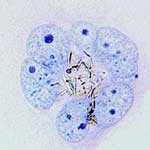 One of the complications of nanotoxicology is that the toxicity of a specific nanomaterial cannot be predicted from the toxicity of the same material in a different form. For instance, while the toxicity of inert systems such as iron oxides, gold, or silver has been investigated for nearly isotropic particles, the toxicity of these materials in nanofilament form cannot be predicted from their known toxicity as nanoparticles. Fully understanding the toxic mechanisms of nanoscale materials is an essential prerequisite in being able to design harmless nanomaterials whose interactions with biological cells is non-lethal. Currently, a lot of nanotoxicological research effort is focused on carbon nanotubes, but nanofilaments are not exclusively based on carbon materials and can be produced from many inorganic materials in the form of nanotubes and nanowires. Applying the 'precautionary principle' to nanotechnology would require much more extensive nanotoxicological research on all types of nanomaterials; and there seems to be a particular lack of findings concerning non-carbon nanofilaments. Researchers in Switzerland have now taken a closer look at the fate of titanium dioxide (TiO2) based nanofilaments in the body. Their results are cause for concern.
One of the complications of nanotoxicology is that the toxicity of a specific nanomaterial cannot be predicted from the toxicity of the same material in a different form. For instance, while the toxicity of inert systems such as iron oxides, gold, or silver has been investigated for nearly isotropic particles, the toxicity of these materials in nanofilament form cannot be predicted from their known toxicity as nanoparticles. Fully understanding the toxic mechanisms of nanoscale materials is an essential prerequisite in being able to design harmless nanomaterials whose interactions with biological cells is non-lethal. Currently, a lot of nanotoxicological research effort is focused on carbon nanotubes, but nanofilaments are not exclusively based on carbon materials and can be produced from many inorganic materials in the form of nanotubes and nanowires. Applying the 'precautionary principle' to nanotechnology would require much more extensive nanotoxicological research on all types of nanomaterials; and there seems to be a particular lack of findings concerning non-carbon nanofilaments. Researchers in Switzerland have now taken a closer look at the fate of titanium dioxide (TiO2) based nanofilaments in the body. Their results are cause for concern.
Jul 27th, 2009
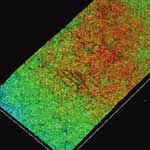 Developing bioassays that are simple, portable, disposable and inexpensive will provide important tools to rapidly detect toxic substances. This technology could also be extremely useful in monitoring environmental and food-based toxins in remote settings such as less industrialized countries where these tools are essential for the first stages of detecting disease settings and where the time and expense of using sophisticated instrumentation would be prohibitive. To that end, researchers have developed simple, portable, disposable, and inexpensive paper-based solid-phase sensors to run multiple bioassays and controls simultaneously. Bioactive paper is any low-cost and easy-to-use paper product laced with biologically active chemicals that provides a rapid way to detect toxins like E. coli bacteria and salmonella, or pathogens such as SARS or influenza.
Developing bioassays that are simple, portable, disposable and inexpensive will provide important tools to rapidly detect toxic substances. This technology could also be extremely useful in monitoring environmental and food-based toxins in remote settings such as less industrialized countries where these tools are essential for the first stages of detecting disease settings and where the time and expense of using sophisticated instrumentation would be prohibitive. To that end, researchers have developed simple, portable, disposable, and inexpensive paper-based solid-phase sensors to run multiple bioassays and controls simultaneously. Bioactive paper is any low-cost and easy-to-use paper product laced with biologically active chemicals that provides a rapid way to detect toxins like E. coli bacteria and salmonella, or pathogens such as SARS or influenza.
Jul 24th, 2009
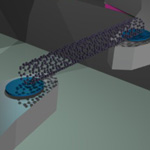 The fundamental issue of large-scale carbon nanotube (CNT) device fabrication remains the biggest challenge for effective commercialization of CNT-based nanoelectronic devices. For CNT electronics to become a reality requires manufacturing techniques to simultaneously and reproducibly fabricate a very large number of such devices on a single chip, each accessible individually for electronic transport. Conventional nanotube growth and device fabrication techniques using chemical vapor deposition or spin-casting are unable to achieve this, due to a lack of precise control over nanotube positioning and orientation. New work conducted at Tel Aviv University utilizes the CVD growth of CNTs over pillar-patterned silicon substrates to facilitate the formation of devices with taut and aligned CNTs grown exclusively at desired positions with built-in electrical contacts.
The fundamental issue of large-scale carbon nanotube (CNT) device fabrication remains the biggest challenge for effective commercialization of CNT-based nanoelectronic devices. For CNT electronics to become a reality requires manufacturing techniques to simultaneously and reproducibly fabricate a very large number of such devices on a single chip, each accessible individually for electronic transport. Conventional nanotube growth and device fabrication techniques using chemical vapor deposition or spin-casting are unable to achieve this, due to a lack of precise control over nanotube positioning and orientation. New work conducted at Tel Aviv University utilizes the CVD growth of CNTs over pillar-patterned silicon substrates to facilitate the formation of devices with taut and aligned CNTs grown exclusively at desired positions with built-in electrical contacts.
Jul 23rd, 2009
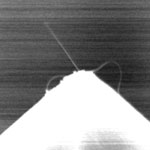 Carbon nanotubes, like the nervous cells of our brain, are excellent electrical signal conductors and can form intimate mechanical contacts with cellular membranes, thereby establishing a functional link to neuronal structures. There is a growing body of research on using nanomaterials in neural engineering. Most studies simply grow carbon nanotubes over microelectrodes to interface with neurons extracellularly. Such an extracellular interface is non-invasive, but it only allows the action potential of neurons to be recorded. In contrast, an intracellular interface allows all of the sophisticated neural activity to be probed, but it is an invasive approach that usually destroys the neuron. Now, new research by scientists in Taiwan is the first to explore the feasibility of using CNTs to probe neural activity intracellularly, opening the way for intracellular neural probes that minimize damage to the neuron.
Carbon nanotubes, like the nervous cells of our brain, are excellent electrical signal conductors and can form intimate mechanical contacts with cellular membranes, thereby establishing a functional link to neuronal structures. There is a growing body of research on using nanomaterials in neural engineering. Most studies simply grow carbon nanotubes over microelectrodes to interface with neurons extracellularly. Such an extracellular interface is non-invasive, but it only allows the action potential of neurons to be recorded. In contrast, an intracellular interface allows all of the sophisticated neural activity to be probed, but it is an invasive approach that usually destroys the neuron. Now, new research by scientists in Taiwan is the first to explore the feasibility of using CNTs to probe neural activity intracellularly, opening the way for intracellular neural probes that minimize damage to the neuron.
Jul 22nd, 2009
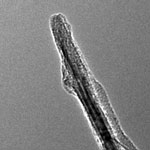 Carbon nanotubes have long been recognized as a promising material for the storage of hydrogen. Back in 2003, researchers first synthesized carbon nanoscrolls - another carbon nanomaterial similar to multi-walled carbon nanotubes - that was reported to be promising for hydrogen storage. Carbon nanoscrolls (CNS) can be obtained by rolling up a graphene sheet into a tubular structure. In contrast to multi-walled carbon nanotubes, with CNS one can vary the distance between layers, a property that might be crucial for gas storage applications. CNS are also expected to be useful in other applications, for instance in nanoelectronics, since they inherit some properties from both graphene and carbon nanotubes, e.g. high mechanical strength and carrier mobility. However, theoretical calculations also predict some unusual electronic and optical properties of CNS due to their unique topology. Previously, several methods have been developed to make CNS. However, they were hard to control, difficult to purify, and the fabricated scrolls were found to possess poor morphology. Now, researchers in Beijing have developed a simple and effective technique for fabricating high-quality CNS.
Carbon nanotubes have long been recognized as a promising material for the storage of hydrogen. Back in 2003, researchers first synthesized carbon nanoscrolls - another carbon nanomaterial similar to multi-walled carbon nanotubes - that was reported to be promising for hydrogen storage. Carbon nanoscrolls (CNS) can be obtained by rolling up a graphene sheet into a tubular structure. In contrast to multi-walled carbon nanotubes, with CNS one can vary the distance between layers, a property that might be crucial for gas storage applications. CNS are also expected to be useful in other applications, for instance in nanoelectronics, since they inherit some properties from both graphene and carbon nanotubes, e.g. high mechanical strength and carrier mobility. However, theoretical calculations also predict some unusual electronic and optical properties of CNS due to their unique topology. Previously, several methods have been developed to make CNS. However, they were hard to control, difficult to purify, and the fabricated scrolls were found to possess poor morphology. Now, researchers in Beijing have developed a simple and effective technique for fabricating high-quality CNS.
Jul 20th, 2009
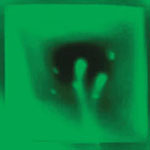 Controlling surface plasmons has become increasingly attractive for optical signal processing, surface enhanced spectroscopy and sensor nanotechnology. For instance, the role of surface plasmon resonance (SPR) on resonant transmission through nanohole arrays has motivated their application as surface-based biosensors. New work by a team of scientists in Canada has combined nanofluidics and nanoplasmonics for SPR sensing using flow-through nanohole arrays. This new format enables rapid transport of reactants to the active sensing surface and the array serves as a sieve. That is, the flow-through array efficiently collects and detects biomarkers from a very small volume of fluid.
Controlling surface plasmons has become increasingly attractive for optical signal processing, surface enhanced spectroscopy and sensor nanotechnology. For instance, the role of surface plasmon resonance (SPR) on resonant transmission through nanohole arrays has motivated their application as surface-based biosensors. New work by a team of scientists in Canada has combined nanofluidics and nanoplasmonics for SPR sensing using flow-through nanohole arrays. This new format enables rapid transport of reactants to the active sensing surface and the array serves as a sieve. That is, the flow-through array efficiently collects and detects biomarkers from a very small volume of fluid.
Jul 17th, 2009
 Nanotechnology plays, or rather: will play, a major role in technical and biological human enhancement. A recently released study commissioned by the European Parliament attempts to bridge the gap between visions on human enhancement and the relevant technoscientific developments. It outlines possible strategies of how to deal with human enhancement in a European context, identifying a reasoned pro-enhancement approach, a reasoned restrictive approach and a case-by-case approach as viable options for the EU. The authors propose setting up a European body for the development of a normative framework that guides the formulation of EU policies on human enhancement.
Nanotechnology plays, or rather: will play, a major role in technical and biological human enhancement. A recently released study commissioned by the European Parliament attempts to bridge the gap between visions on human enhancement and the relevant technoscientific developments. It outlines possible strategies of how to deal with human enhancement in a European context, identifying a reasoned pro-enhancement approach, a reasoned restrictive approach and a case-by-case approach as viable options for the EU. The authors propose setting up a European body for the development of a normative framework that guides the formulation of EU policies on human enhancement.
Jul 16th, 2009
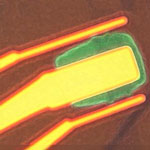 The most promising applications of graphene are in electronics, detectors, and thermal management. The first graphene field-effect transistors have already been demonstrated. At the same time, for any transistor to be useful for analog communication or digital applications, the level of the electronic low-frequency noise has to be decreased to an acceptable level. Low frequency electronic noise dominates the noise spectrum to a frequency of about 100 kHz. Despite the fact that modern electronic devices such as cell phones and radars operate at a much higher carrier frequency, the low frequency noise is extremely important. Due to unavoidable non-linearities in devices and systems, the low frequency noise gets up-converted, and contributes to the phase noise of the system, thus limiting its performance. It is not possible to build a communication system or detector based on graphene devices until the noise spectral density is decreased to the level comparable with the conventional state-of-the-art transistors. Researchers at the University of California - Riverside have now reported the results of experimental investigation of the low-frequency noise in a double-gate graphene transistors.
The most promising applications of graphene are in electronics, detectors, and thermal management. The first graphene field-effect transistors have already been demonstrated. At the same time, for any transistor to be useful for analog communication or digital applications, the level of the electronic low-frequency noise has to be decreased to an acceptable level. Low frequency electronic noise dominates the noise spectrum to a frequency of about 100 kHz. Despite the fact that modern electronic devices such as cell phones and radars operate at a much higher carrier frequency, the low frequency noise is extremely important. Due to unavoidable non-linearities in devices and systems, the low frequency noise gets up-converted, and contributes to the phase noise of the system, thus limiting its performance. It is not possible to build a communication system or detector based on graphene devices until the noise spectral density is decreased to the level comparable with the conventional state-of-the-art transistors. Researchers at the University of California - Riverside have now reported the results of experimental investigation of the low-frequency noise in a double-gate graphene transistors.
Jul 14th, 2009
 One of the complications of nanotoxicology is that the toxicity of a specific nanomaterial cannot be predicted from the toxicity of the same material in a different form. For instance, while the toxicity of inert systems such as iron oxides, gold, or silver has been investigated for nearly isotropic particles, the toxicity of these materials in nanofilament form cannot be predicted from their known toxicity as nanoparticles. Fully understanding the toxic mechanisms of nanoscale materials is an essential prerequisite in being able to design harmless nanomaterials whose interactions with biological cells is non-lethal. Currently, a lot of nanotoxicological research effort is focused on carbon nanotubes, but nanofilaments are not exclusively based on carbon materials and can be produced from many inorganic materials in the form of nanotubes and nanowires. Applying the 'precautionary principle' to nanotechnology would require much more extensive nanotoxicological research on all types of nanomaterials; and there seems to be a particular lack of findings concerning non-carbon nanofilaments. Researchers in Switzerland have now taken a closer look at the fate of titanium dioxide (TiO2) based nanofilaments in the body. Their results are cause for concern.
One of the complications of nanotoxicology is that the toxicity of a specific nanomaterial cannot be predicted from the toxicity of the same material in a different form. For instance, while the toxicity of inert systems such as iron oxides, gold, or silver has been investigated for nearly isotropic particles, the toxicity of these materials in nanofilament form cannot be predicted from their known toxicity as nanoparticles. Fully understanding the toxic mechanisms of nanoscale materials is an essential prerequisite in being able to design harmless nanomaterials whose interactions with biological cells is non-lethal. Currently, a lot of nanotoxicological research effort is focused on carbon nanotubes, but nanofilaments are not exclusively based on carbon materials and can be produced from many inorganic materials in the form of nanotubes and nanowires. Applying the 'precautionary principle' to nanotechnology would require much more extensive nanotoxicological research on all types of nanomaterials; and there seems to be a particular lack of findings concerning non-carbon nanofilaments. Researchers in Switzerland have now taken a closer look at the fate of titanium dioxide (TiO2) based nanofilaments in the body. Their results are cause for concern. 
 Subscribe to our Nanotechnology Spotlight feed
Subscribe to our Nanotechnology Spotlight feed





